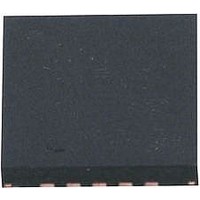LTC4160EUDC#PBF Linear Technology, LTC4160EUDC#PBF Datasheet - Page 17

LTC4160EUDC#PBF
Manufacturer Part Number
LTC4160EUDC#PBF
Description
IC, BATT CHRG, Li-Ion, Li-Polymer, 1.2A, QFN20
Manufacturer
Linear Technology
Datasheet
1.LTC4160EPDCPBF.pdf
(32 pages)
Specifications of LTC4160EUDC#PBF
Battery Type
Li-Ion, Li-Polymer
Input Voltage
5.5V
Battery Charge Voltage
4.2V
Charge Current Max
1.2A
Battery Ic Case Style
QFN
No. Of Pins
20
No. Of Series Cells
1
Rohs Compliant
Yes
Lead Free Status / RoHS Status
Lead free / RoHS Compliant
Available stocks
Company
Part Number
Manufacturer
Quantity
Price
OPERATION
the voltage at V
the voltage at BAT. Within the amplifier’s linear range, the
small-signal resistance of the ideal diode will be quite low,
keeping the forward drop near 15mV. At higher current
levels, the MOSFET will be in full conduction.
To supplement the internal ideal diode, an external P-
channel MOSFET may be added from BAT to V
IDGATE pin of the LTC4160/LTC4160-1 drives the gate of
the external P-channel MOSFET for automatic ideal diode
control. The source of the external P-channel MOSFET
should be connected to V
nected to BAT. Capable of driving a 1nF load, the IDGATE
pin can control an external P-channel MOSFET having an
on-resistance of 30mΩ or lower.
Suspend LDO
If the LTC4160/LTC4160-1 is configured for USB suspend
mode, the bidirectional switching regulator is disabled and
the suspend LDO provides power to the V
suming there is power available at V
prevent the battery from running down when the portable
product has access to a suspended USB port. Regulating at
4.6V, this LDO only becomes active when the bidirectional
switching regulator is disabled (suspended). The sus-
pend LDO sends a scaled copy of the V
CLPROG pin, which will servo to approximately 100mV in
this mode. In accordance with the USB specification, the
input to the LDO is current limited so that it will not exceed
the low power suspend specification. If the load on V
exceeds the suspend current limit, the additional current
will come from the battery via the ideal diode(s).
3.3V Always-On LDO Supply
The LTC4160/LTC4160-1 include a low quiescent current
low dropout regulator that is always powered. This LDO
can be used to provide power to a system pushbutton
controller, standby microcontroller or real time clock.
Designed to deliver up to 20mA, the always-on LDO re-
quires at least a 1μF multilayer ceramic bypass capacitor
for compensation. The LDO is powered from V
therefore will enter dropout at loads less than 20mA as
V
should be disabled by connecting it to V
OUT
falls near 3.3V. If the LDO3V3 output is not used, it
OUT
is approximately 15mV (V
OUT
and the drain should be con-
BUS
BUS
OUT
). This LDO will
current to the
OUT
.
FWD
pin (pre-
OUT
OUT
) below
. The
, and
OUT
Battery Charger
The LTC4160/LTC4160-1 include a constant-current/con-
stant-voltage battery charger with automatic recharge,
automatic termination by safety timer, low voltage trickle
charging, bad cell detection, and thermistor sensor input
for out-of-temperature charge pausing. The charger can
be disabled using the ENCHARGER pin.
Battery Preconditioning
When a battery charge cycle begins, the battery charger
first determines if the battery is deeply discharged. If the
battery voltage is below V
trickle charge feature sets the battery charge current to
10% of the programmed value. If the low voltage persists
for more than a 1/2 hour, the battery charger automatically
terminates and indicates via the CHRG and FAULT pins that
the battery was unresponsive.
Once the battery voltage is above 2.85V, the charger begins
charging in full power constant-current mode. The cur-
rent delivered to the battery will try to reach 1030/R
Depending on available input power and external load
conditions, the battery charger may or may not be able
to charge at the full programmed rate. The external load
will always be prioritized over the battery charge current.
Likewise, the USB current limit programming will always
be observed and only additional power will be available to
charge the battery. When system loads are light, battery
charge current will be maximized.
Charge Termination
The battery charger has a built-in safety timer. When the
voltage on the battery reaches the pre-programmed float
voltage, the battery charger will regulate the battery volt-
age and the charge current will decrease naturally. Once
the battery charger detects that the battery has reached
the float voltage, the four hour safety timer is started.
After the safety timer expires, charging of the battery will
discontinue and no more current will be delivered.
Automatic Recharge
After the battery charger terminates, it will remain off
drawing only microamperes of current from the battery.
If the portable product remains in this state long enough,
LTC4160/LTC4160-1
TRKL
, typically 2.85V, an automatic
17
PROG
41601fa
.













